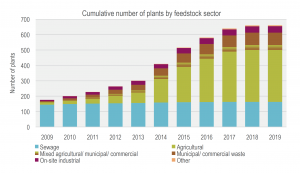A blog by Dr Semra Bakkaloglu, a Research Associate at the  Sustaianable Gas Institute.
Sustaianable Gas Institute.
Biogas production could have an important role in renewable energy, reducing the adverse effects on the climate. However, biogas production’s contribution to emissions of the greenhouse gas, methane, is not fully understood. Methane (CH4) is the second most potent and abundant greenhouse gas after carbon dioxide (CO2) but because it only lasts in the atmosphere for short time (a decade) reducing methane emissions could have a more rapid impact on mitigating climate change. Unfortunately, there are significant discrepancies between official inventories of methane emissions and estimates derived from direct atmospheric measurement of biogas plants. If biogas is to be a solution to climate change, we need to find effective emission methane reduction strategies, and sources also need to be properly quantified.
What is biogas?
According to the United Nations Framework Convention on Climate Change (UNFCCC), biogas is defined as gas generated from anaerobic digesters. Biogas plant feed may be any biodegradable material, such as dedicated energy crops, agricultural residues, organic waste and paper mill waste. The integrated process in biogas plants includes feedstock supply and pre-treatment, gas treatment and utilisation, and recovery, pre-treatment and use of digestate (Wellinger et al., 2013). This comprises 50 to 70% methane, 30 to 50% CO2 and traces (1 to 5%) of hydrogen suphide and ammonia (National Non-Food Crops Centre, 2021). Biogas is used for heating, electricity or both. If biogas is upgraded to biomethane by removing other gases, biomethane has similar properties to natural gas and can be injected into gas grid or used as a road fuel.
Emissions from biogas plants
Biogas production has an important place in renewable energy, reducing the adverse effects on the climate. However, high methane emissions from biogas plants can arise from fugitive emissions. Depending on engine construction, plant design and operation conditions, emissions can occur through venting from compressors, pipes, single large leaks or long-lasting pressure relief valves and incomplete combustions from combined heat and power units.

Biogas plants not accounted for
Waste practices in the EU and the UK have changed recently as more waste is being diverted from landfill to biogas plants and composting facilities. There are 579 biogas plants in the UK (National Non-Food Crops Centre, 2021) and their number of biogas plants has grown in the last decade (Figure 2). Unfortunately, most have not been included in the National Atmospheric Emission Inventory (NAEI).
The sustainability of biogas plants depends on the land requirement and greenhouse gas accounting (OFGEM, 2018). However, studies have shown that there is often a maximum loss of 9% of the total production rate of methane (Bakkaloglu et al., 2021; Scheutz and Fredenslud, 2019, and Samuelsson et al. 2018). Also, research conducted by my colleagues and I at Royal Holloway in 2021, demonstrated that biogas plants emissions may account for up to 3.8% of the total methane emissions in the UK. This does not include the sewage sludge biogas plants. We therefore need robust, consistent emission measurements in the UK. Legal requirements should also be implemented, not only UK Net Zero Commitment, but also for the sustainability of biogas plants.
Biogas in the UK’s Net-Zero Commitment

On 27 June 2019, the UK government committed to achieving net-zero Carbon emissions by 2050, in line with the UN’s Paris Agreement (Climate Change Committee, 2019). This Agreement sets out many recommendations as to how to achieve net-zero targeted, including:
- Diversion of all biodegradable waste from landfills to anaerobic digesters or composting facilities by 2025.
- Measures to reduce emissions from livestock, soils and waste manure.
- Elimination of food waste as far as possible, and separation of food waste collections
- Full utilisation of the UK’s biogenic waste sources, including residues from agriculture and forestry.
According to a recent article on the UN website in December 2020, more than 110 countries have a carbon neutral strategy by 2050 but this aim can only be achieved with appropriate reduction methods. As a result of this zero-commitment, biogas plants have assumed a more significant role, not only in the renewable energy market but also in waste strategies.
Although emissions from biogas plants have not, as yet, attracted serious attention, they may jeopardise the net-zero commitment unless the necessary action is taken.
References
- Angelidaki, I., et al, 2018. Biogas upgrading and utilization: Current status and perspectives. Biotechnology Advances, 36(2): 452–466.
- Bakkaloglu, S., et al, 2021. Quantification of methane emissions from UK biogas plants. Waste Manage. 124, 82–93.
- CCC, 2019. Net Zero Technical Report. Committee on Climate Change, London.
- Daniel-Gromke, J., et al., 2015. Digestion of bio-waste-GHG emissions and mitigation potential. Energy Sustain. Soc. 5, art. 3.
Fredenslund, A., et al 2018. On-site and ground-based remote sensing measurements of methane emissions from four biogas plants: A comparison study. Bioresour. Technol. 270, 88–95. - Kvist, T., et al., 2019. Methane loss from commercially operating biogas upgrading plants. Waste Manage. 87, 295–300.
- Liebetrau, J., et al., 2017. Methane Emissions from Biogas Plants: Methods for Measurement, Results and Effect on Greenhouse Gas Balance of Electricity Produced. IEA Bioenergy, Paris, France.
- NAEI, 2021. National Atmospheric Emissions Inventory in 2018. London: NAEI. Available:
- NNFCC, 2021. The official information portal on anaerobic digestion.
- Reinelt, T., et al., 2017. Comparative use of different emission measurement approaches to determine methane emissions from a biogas plant. Waste Manage. 68, 173–185.
- Reinelt, T., Liebetrau, J., 2019. Monitoring and mitigation of methane emissions from pressure relief valves of a biogas plant. Chem. Eng. Technol. 43, 7–18.
- Samuelsson, J., et al., 2018. Optical technologies applied alongside on-site and remote approaches for climate gas emission quantification at a wastewater treatment plant. Water Res. 131, 299–309.
- Scheutz, C.,et al A.M., 2019. Total methane emission rates and losses from 23 biogas plants. Waste Manage. 97, 38–46.
- UNFCCC, 2017. Methodological Tool, Project and Leakage Emissions from Anaerobic Digestion. United Nations Framework Convention on Climate Change, Geneva, Switzerland.
- Wellinger, A., Murphy, J., and Baxter, D., 2013. The Biogas Handbook: Science, Production and Applications. Oxford: Woodhead Publishing.
- UN News, 2020. The race to zero emissions, and why the world depends on it [website] (accessed on May 11, 2020).